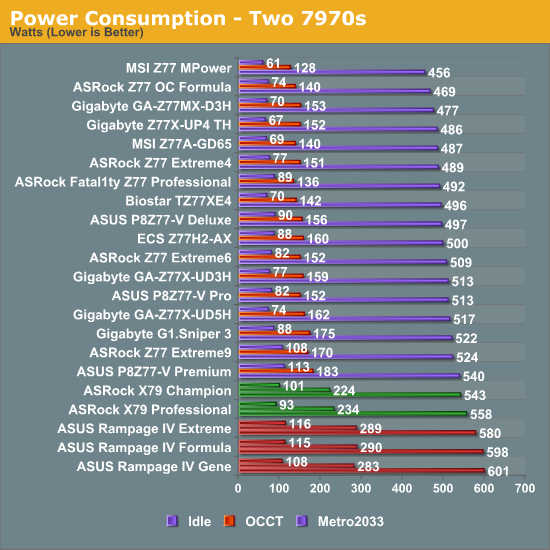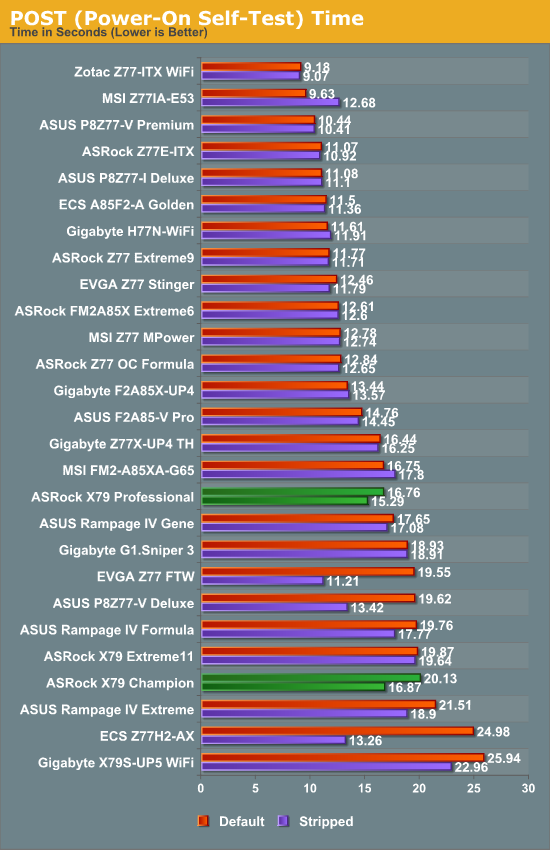ASRock Fatal1ty X79 Champion and X79 Professional Review: From a Gamer to Gamers
by Ian Cutress on February 9, 2013 10:30 AM EST- Posted in
- Motherboards
- ASRock
- Fatal1ty
- X79
Many thanks to...
We must thank the following companies for kindly providing hardware for our test bed:
Thank you to OCZ for providing us with the 1250W Gold Power Supply and USB testing SSD.
Thank you to Micron for providing us with the SATA testing SSD.
Thank you to G.Skill for providing us with the memory kits.
Thank you to ASUS for providing us with the AMD GPUs and some IO Testing kit.
Thank you to ECS for providing us with the NVIDIA GPUs.
Additionally, many thanks to Corsair for providing us with the Corsair H80i CLC, as this is the first time we are using this unit in motherboard testing. The H80i is the Corsair Link enabled and updated version of the H80, the closed-loop liquid cooling system with a 120mm double width radiator. Dustin reviewed the unit at the beginning of the year, and is currently available for $95.
Test Setup
| Test Setup | |
| Processor |
Intel Core i7-3960X 6 Cores, 12 Threads, 3.3 GHz (3.9 GHz Turbo) |
| Motherboards |
ASRock X79 Professional ASRock X79 Champion |
| Cooling | Corsair H80i CLC |
| Power Supply | OCZ 1250W Gold ZX Series |
| Memory | GSkill RipjawsZ 4x4 GB DDR3-2400 10-12-12 |
| Memory Settings | 2133 10-12-12 |
| Video Cards |
ASUS HD7970 3GB ECS GTX 580 1536MB |
| Video Drivers |
Catalyst 12.3 NVIDIA Drivers 296.10 WHQL |
| Hard Drive | Micron RealSSD C300 256GB |
| Optical Drive | LG GH22NS50 |
| Case | Open Test Bed - CoolerMaster Lab V1.0 |
| Operating System | Windows 7 64-bit |
| SATA Testing | Micron RealSSD C300 256GB |
| USB 2/3 Testing | OCZ Vertex 3 240GB with SATA->USB Adaptor |
Power Consumption
Power consumption was tested on the system as a whole with a wall meter connected to the OCZ 1250W power supply, while in a dual 7970 GPU configuration. This power supply is Gold rated, and as I am in the UK on a 230-240 V supply, leads to ~75% efficiency > 50W, and 90%+ efficiency at 250W, which is suitable for both idle and multi-GPU loading. This method of power reading allows us to compare the power management of the UEFI and the board to supply components with power under load, and includes typical PSU losses due to efficiency. These are the real world values that consumers may expect from a typical system (minus the monitor) using this motherboard.
While this method for power measurement may not be ideal, and you feel these numbers are not representative due to the high wattage power supply being used (we use the same PSU to remain consistent over a series of reviews, and the fact that some boards on our test bed get tested with three or four high powered GPUs), the important point to take away is the relationship between the numbers. These boards are all under the same conditions, and thus the differences between them should be easy to spot.

Power consumption on the ASRock boards is much lower than that of the ASUS Rampage boards, especially during OCCT loading.
Windows 7 POST Time
Different motherboards have different POST sequences before an operating system is initialized. A lot of this is dependent on the board itself, and POST boot time is determined by the controllers on board (and the sequence of how those extras are organized). As part of our testing, we look at the POST Boot Time - this is the time from pressing the ON button on the computer to when Windows starts loading. (We discount Windows loading as it is highly variable given Windows specific features.) Despite the advent of Windows 8 introducing features for quick booting within several seconds, a significant number of users are still on Windows 7, where POST times usually fall in the 7-25 second range. For a good result, we are looking for around 12 seconds when the board has two GPUs fitted (one for mITX), as per our testing. We test both the stock boot time (with BIOS at default), and a stripped BIOS where all extra onboard controllers (LAN, USB 3.0, SATA, etc.) are disabled.

Unfortunately the Champion falls down on boot times, hitting over 20 seconds at default but saving a little grace with 16.87 seconds when stripped. The Professional has a better time, beating the stripped Champion while at stock, and going a little further when stripped. Neither however have great boot times.











71 Comments
View All Comments
CeriseCogburn - Wednesday, February 13, 2013 - link
Yes, which he is not.He is a soft skinned, supple handed, soft spoken, slow and controlled quite kind wuss-a-moe.
AssBall - Wednesday, February 13, 2013 - link
WTF? Slow work day for you? Someone pee in your Cheerios? Can't find a better board to troll? Go do something useful like electrocute yourself with your vibrator.jason_mcallister - Monday, February 11, 2013 - link
I have the Z77 version of this motherboard. It's pretty solid. I didn't buy it for the marketing but for the 10 SATA ports. ASROCK does support this MB well, I recently got a BIOS update and the website support page has recent drivers updates for windows 8. Yes the board is gimmicky but so what if it has the major features I'm looking for. It's not a bad looking board either.UltraTech79 - Monday, February 11, 2013 - link
I can't believe this BS brand is still trying. Who the hell buys this crap? Do they realize that the whole fatal1ty horseshit is making people NOT want to buy an otherwise nice board? make it stop.CeriseCogburn - Thursday, February 14, 2013 - link
All the little insane amd fanboys bought the amd crap because a PR fantasy mind bending half naked ho was on the video card...The double D knockers fan was another recent amd sexual sales tool, for the tools.
Don't expect most here to miss out being manipulated idiots, even if they caught on from the 1st post it was time to whine about fatal1ty like good little sheep.
Origin64 - Tuesday, February 12, 2013 - link
quote: One would also expect some form of network interface to reduce CPU consumption / prioritize gaming traffic, but rather than going the Atheros Killer route, ASRock use Broadcom NICs and software.I wouldn't expect it. Those cards do not offer increased performance over any other networking solution, but they do cost 100 bucks more. It's a scam designed to target people who think more expensive means more better.
Solix - Tuesday, February 12, 2013 - link
Please people, stop purchasing anything with this branding so:a) He can stop getting pointless cuts of the profits when as others point out he hasn't done anything particularly interesting
b) They will stop making this crap and put out real enthusiast boards
I'd like to actually purchase some of the upper end boards but I refuse to do based on marketing crap. If they want to brand it with someone I'd be more impressed with naming it after some awesome electrical engineer or circuit / cpu designer; heh.
lever_age - Wednesday, February 13, 2013 - link
Hm, I think there are already a lot of "black edition" parts out there. Harold Black, inventer of the negative-feedback amplifier? heh.I don't know if you can count it as it's so far back and not really a branding, but Nvidia has some Tesla cards to sell you. And a lot of their code names are scientists of course.
So for circuits, Jack Kilby (Nobel prize for first integrated circuit), Bob Widlar (IC design, but analog). Plenty of names escape me at the moment.
For high-performance computing, let's start with Seymour Cray... wait a sec...
LoneWolf15 - Wednesday, February 13, 2013 - link
For the Babality edition.JonnyDough - Friday, February 15, 2013 - link
Fatal1ty is one of the few gamers out there who isn't obese and smoke a lot of pot. LOL That's why he's made his millions.